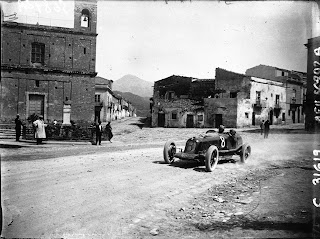The first Formula One world champion
 |
| Giuseppe 'Nino' Farina had family roots in the automotive industry |
Emilio Giuseppe Farina, driving an Alfa Romeo, became
the first Formula One world champion on this day in 1950.
The 43-year-old driver from Turin - usually known as Giuseppe or 'Nino' - clinched the title on home
territory by winning the Italian Grand Prix at Monza.
He was only third in the seven-race inaugural championship
going into the final event at the Lombardy circuit, trailing Alfa teammates
Juan Manuel Fangio, of Argentina, by four points and his Italian compatriot,
Luigi Fagioli, by two.
Under the competition’s complicated points scoring system, Fangio
was hot favourite, with the title guaranteed if he was first or second, and
likely to be his if he merely finished in the first five, provided Farina did
not win. He could have been crowned
champion simply by picking up a bonus point for the fastest lap in the race,
provided Farina was no higher than third.
Fagioli could take the title only by winning the race with
the fastest lap, provided Farina was third or lower and Fangio failed to
register a point.
Farina could win the title only by winning the race,
recording the fastest lap and hoping Fangio finished no better than third
place. A top-three finish with the
fastest lap bonus would do if Fangio did not score at all.
 |
| Farina on the cover of the Argentine motor racing magazine El Gráfico in 1953 |
In the event, Farina won and Fangio had a bad day, retiring
twice – first in his own car, on which the greabox failed, and then in team-mate Piero Taruffi’s Alfa. He scored one point for the fastest lap, but that on
its own was not enough.
It was a third victory of the season for Farina, who had
also triumphed in the British Grand Prix at Silverstone and the Swiss Grand
Prix at Bremgarten.
Born in Turin in 1906, Farina’s roots were in the car business. He was the son of automotive coachbuilder
Giovanni Carlo Farina and the nephew of the brilliant car designer Battista
“Pinin” Farina.
Giuseppe excelled at skiing, football and athletics but was
always likely to opt for motor sport. He
bought his first competition car while still at university and abandoned a
potential career as an officer in the Italian Army in order to fulfil his
ambitions on the track.
He made his competitive debut in 1933 and by 1936 was
driving Alfas for Enzo Ferrari’s Scuderia Ferrari team. In 1937 he won his
first Grand Prix in Naples and by the end of the season was Italian champion, a
title he retained in 1938 and 1939, driving for Alfa Corse, then the official
Alfa Romeo team.
The Second World War almost certainly robbed him of his best years. In the immediate years following, he fell out with Alfa Corse, but had some
successes in a privately-entered Maserati before returning to Scuderia Ferrari.
 |
| Farina in practice at Monza in 1955 |
In 1950, however, he rejoined Alfa and enjoyed his best
season, going back to Ferrari in 1954 only because Alberto Ascari – world
champion in 1952 and 1953 - had left Ferrari and switched to Lancia,
creating a vacancy for team leader.
Farina retired in 1955, after which he became involved in
Alfa Romeo and Jaguar distributorships and later assisted at the Pininfarina
factory. He died in June 1966 at the age
of 59 en route to the French Grand Prix, when he lost control of his Lotus in the Savoy Alps, near Aiguebelle, hit a telegraph pole and was killed
instantly.
Travel tip:
Apart from the motor racing circuit, Monza is notable for
its 13th century Basilica of San Giovanni Battista, often known as Monza
Cathedral, which contains the famous Corona Ferrea or Iron Crown, bearing
precious stones. According to tradition,
the crown was found on Jesus's Cross. Look out also for Villa Reale, built in the neoclassical style by Piermarini
at the end of the 18th Century, which has a sumptuous interior and a court
theatre.
 |
| The church of Santa Giulia in Borgo Vanchiglia |
Travel tip:
Giuseppe Farina’s father established his coachbuilding
business in the historic Borgo Vanchiglia district of Turin, near the
confluence of the Dora Riparia river and the Po. The neo-Gothic church of Santa
Giulia, on Piazzetta Santa Guilia, is at the heart of the neighbourhood, which
is renowned for buildings of unusual design.


